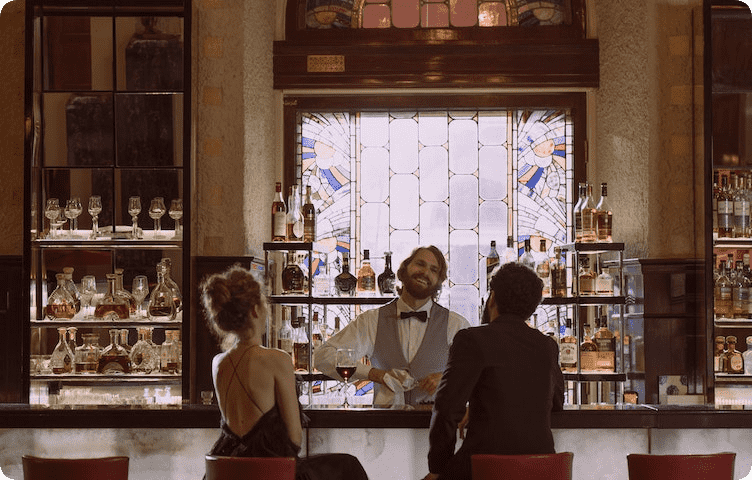Bitter is a flavoring liquid, quite concentrated, has a pronounced taste and can be added to the drink in drops ( dashes , drops ) or in small volumes.
What are bitters?
The word “bitter” itself has English and German roots and literally translates as “bitter” - these are alcoholic drinks based on herbs, spices and spices. The range of bitters is diverse, they differ in density, texture, components, sugar content, but they are united by the obligatory presence of bitterness in the taste. This is a whole category of drinks that is loved all over the world, and many brands of bitters have become legendary and famous.
History of appearance

The appearance of the first bitters is not known for certain; in historical sources one can find mention of bitters made with alcohol, used for medicinal purposes, from the beginning of the 12th century. In the Middle Ages, European countries, one after another, were overcome by diseases associated with the gastrointestinal tract and monks, doctors and pharmacists were looking for all kinds of remedies to eliminate the disease, and so the first bitters were born. Cones, spices, and bitter herbs were infused with alcohol and prescribed as medicine.
And only in the second half of the 19th century did bitter mixtures begin to appear in restaurants, saloons and social gatherings. The public liked them, and already at the beginning of the 20th century, bitters appeared that were aimed directly at drinks. For example, in 1904, Campari bitter appeared - popular to this day. The Italians quite sensitively realized the need for such a drink in the restaurant business market, so they managed to create famous, popular and incredibly tasty drinks at different times, with different compositions.
Aperol, Campari, Fernet – Branca, Ramazzotti – all these are Italian brands that have conquered the whole world.
The Trinidadian Angostura bitter deserves special attention. Its recipe was developed back in 1824 by a German military surgeon as a medicine, and later began to be added to drinks. The Angostura recipe, like the recipes for other legendary drinks, is kept strictly secret. It is only known that the composition includes gentian root, orange peel extract and other medicinal plants and roots. Because of its uniqueness, Angostura is included in more than 100 famous cocktails.
Today, the fashion for bitter drinks has gained new popularity; people in bars are ordering sugary tropical cocktails less and less, preferring sophisticated drinks with a slight bitterness.
How much alcohol is in bitters?
The strength of bitters can vary and vary quite a lot. If we take famous brands, then the strength of Aperol is not at all high and has 11%, but Angostura bitter is already 44.7%. In any case, bitters are quite tart in taste, so they are usually added to drinks in small quantities, and the higher the strength, the less amount should be added to the cocktail. For example, such great cocktails as a Manhattan, Old Fashioned or Sazerac contain only 2-3 drops of bitter, while completely modifying its taste only for the better.
What the experts say

Bitters are great for adjusting the balance of a cocktail. Just a few drops can completely change the flavor profile of a drink so that each ingredient tastes great without overpowering each other.
Bitter is a unique industry tool that is comfortable to work with both a novice bartender and a professional who can even make his own signature bitter in his establishment and add light accents to breathtaking cocktails.
A person’s taste perception is based on 5 main categories, but it is quite difficult to drink a lot of sweet and salty foods. While sour and bitter drinks are not boring. Each time you drink a Negroni or Rob Roy, you can find different nuances of taste without overwhelming your taste buds with sweetness.
Bitters have given the world a unique opportunity to experiment with herbs, spices, alcohols and find new taste and aroma solutions.
















































/https%3A%2F%2Fcomplexbar.com%2Fimages%2Fblog%2F132%2Fbitter_13.28.40.jpg)
/https%3A%2F%2Fcomplexbar.com%2Fimages%2Fblog%2F246%2Funiforma-barmena.jpg)
/https%3A%2F%2Fcomplexbar.com%2Fimages%2Fblog%2F246%2Fkak-nanyat-barmena.jpg)
/https%3A%2F%2Fcomplexbar.com%2Fimages%2Fblog%2F246%2FMadler.jpg)
/https%3A%2F%2Fcomplexbar.com%2Fimages%2Fblog%2F246%2F2024-04-09_17.22.54.jpg)
/https%3A%2F%2Fcomplexbar.com%2Fimages%2Fblog%2F246%2F2024-04-09_17.22.47.jpg)
/https%3A%2F%2Fcomplexbar.com%2Fimages%2Fblog%2F246%2FCODE_anons_foamydrops_752%D1%85480_eng.jpg)
/https%3A%2F%2Fcomplexbar.com%2Fimages%2Fblog%2F246%2FAlina_752%D1%85480_eng.jpg)
/https%3A%2F%2Fcomplexbar.com%2Fimages%2Fblog%2F246%2F2024-04-09_17.23.22.jpg)
/https%3A%2F%2Fcomplexbar.com%2Fimages%2Fblog%2F246%2F2024-04-09_17.23.28.jpg)
/https%3A%2F%2Fcomplexbar.com%2Fimages%2Fblog%2F246%2F2024-04-09_17.23.35.jpg)
/https%3A%2F%2Fcomplexbar.com%2Fimages%2Fblog%2F246%2Fdrinksome_752%D1%85480_eng.jpg)
/https%3A%2F%2Fcomplexbar.com%2Fimages%2Fblog%2F246%2Fnude_752%D1%85480_eng.jpg)
/https%3A%2F%2Fcomplexbar.com%2Fimages%2Fblog%2F246%2F752%D1%85480_eng__1_.jpg)
/https%3A%2F%2Fcomplexbar.com%2Fimages%2Fblog%2F246%2F752%D1%85480_eng.jpg)
/https%3A%2F%2Fcomplexbar.com%2Fimages%2Fblog%2F246%2FStudioRaw_752%D1%85480_eng.jpg)
/https%3A%2F%2Fcomplexbar.com%2Fimages%2Fblog%2F246%2FDoppio_tea_752%D1%85480_eng.jpg)
/https%3A%2F%2Fcomplexbar.com%2Fimages%2Fblog%2F246%2FTognana_Stars_Stripes_752%D1%85480_eng.jpg)
/https%3A%2F%2Fcomplexbar.com%2Fimages%2Fblog%2F246%2FRona_752%D1%85480_eng.jpg)
/https%3A%2F%2Fcomplexbar.com%2Fimages%2Fblog%2F246%2FDoppio_vending_752%D1%85480_eng.jpg)
/https%3A%2F%2Fcomplexbar.com%2Fimages%2Fblog%2F246%2FEssence_sukhie_smesi_752%D1%85480_eng.jpg)
/https%3A%2F%2Fcomplexbar.com%2Fimages%2Fblog%2F246%2FODK_sukhie_smesi752%D1%85480_eng.jpg)
/https%3A%2F%2Fcomplexbar.com%2Fimages%2Fblog%2F246%2Funiforma-barmena.jpg)
/https%3A%2F%2Fcomplexbar.com%2Fimages%2Fblog%2F246%2Fkak-nanyat-barmena.jpg)
/https%3A%2F%2Fcomplexbar.com%2Fimages%2Fblog%2F246%2Fsirop_scale_2400.jpeg)
/https%3A%2F%2Fcomplexbar.com%2Fimages%2Fblog%2F246%2FPeugeot_Anons_Paris_U%27Select_Line_Daman_752%D1%85480_eng.jpg)
/https%3A%2F%2Fcomplexbar.com%2Fimages%2Fblog%2F246%2Fkofe-vostochniy.jpg)
/https%3A%2F%2Fcomplexbar.com%2Fimages%2Fblog%2F246%2FMadler.jpg)
/https%3A%2F%2Fcomplexbar.com%2Fimages%2Fblog%2F246%2Fprofbartender_glavn.jpeg)